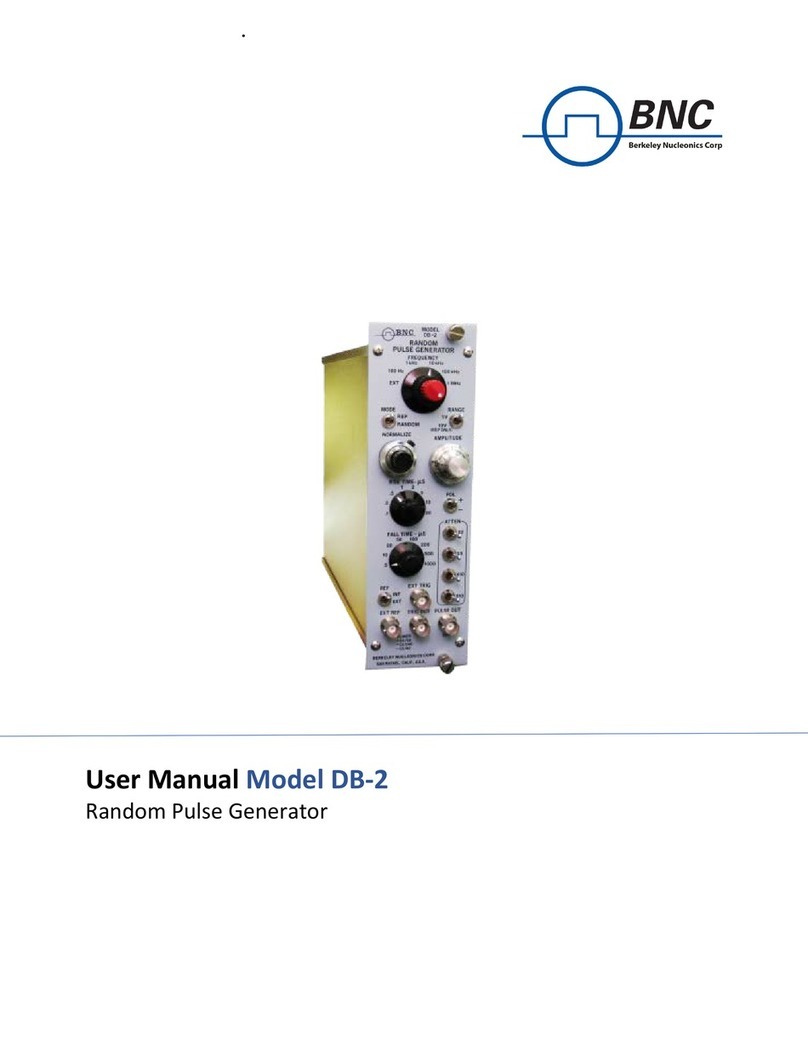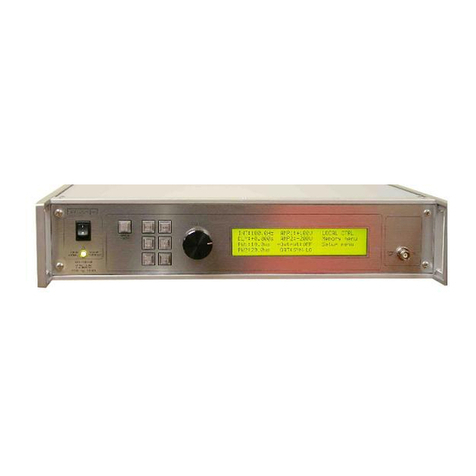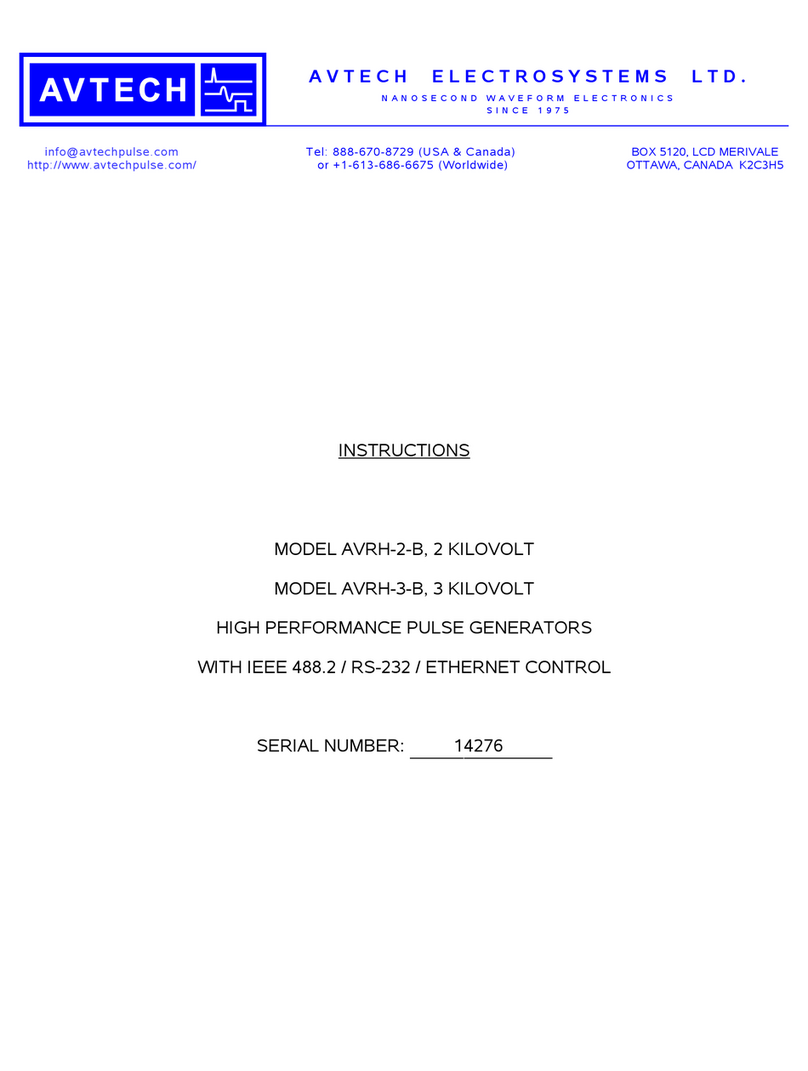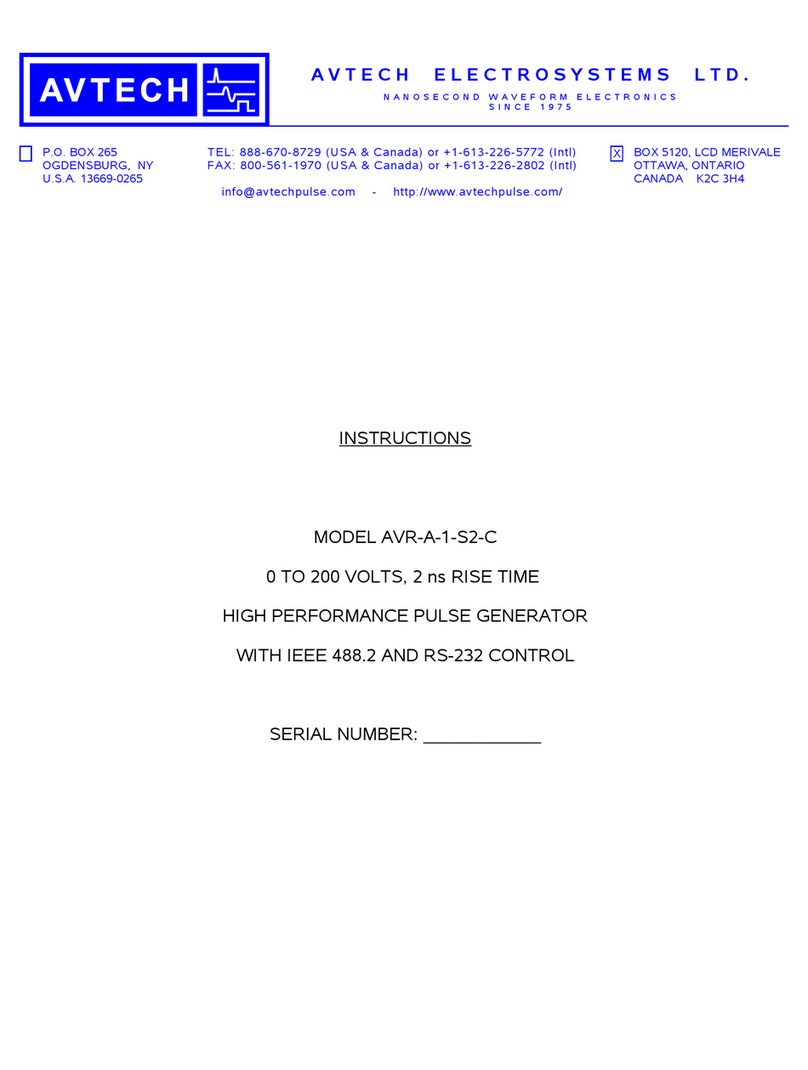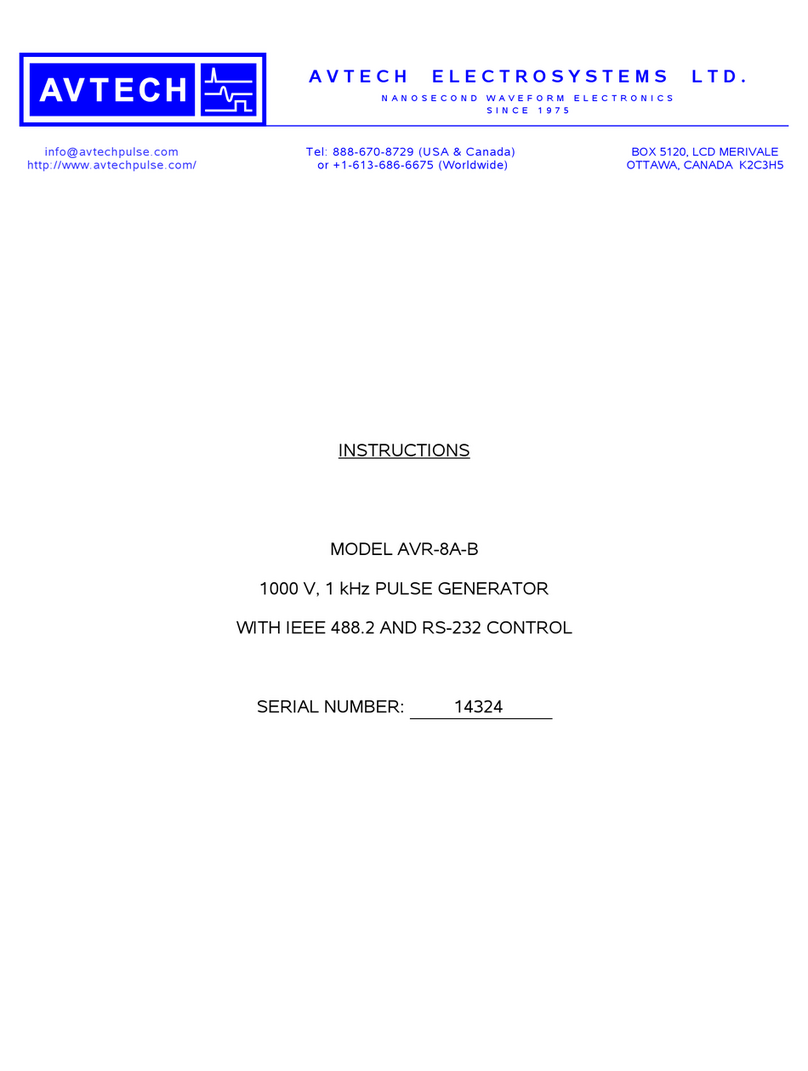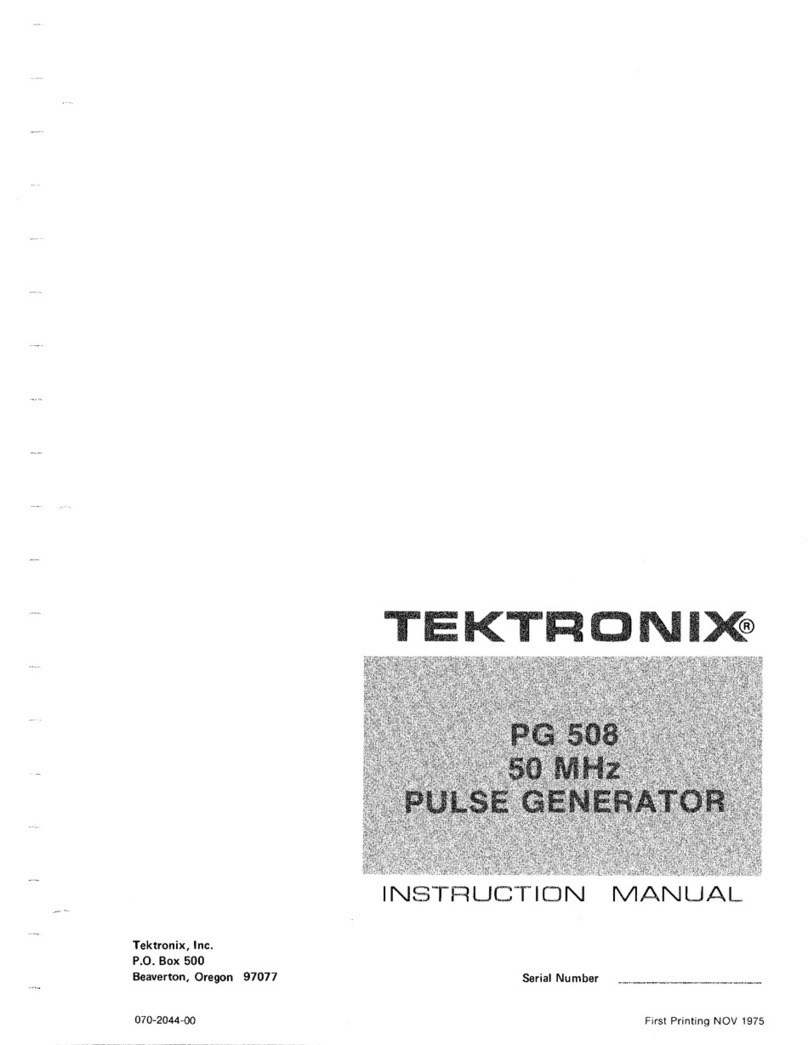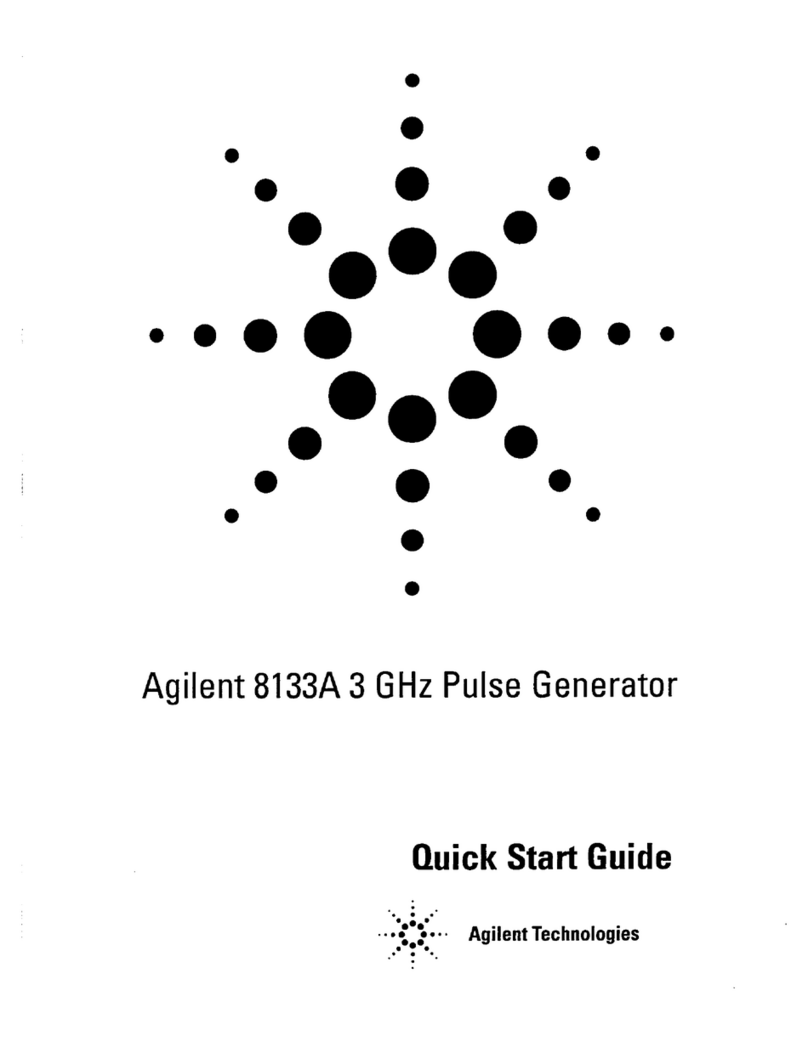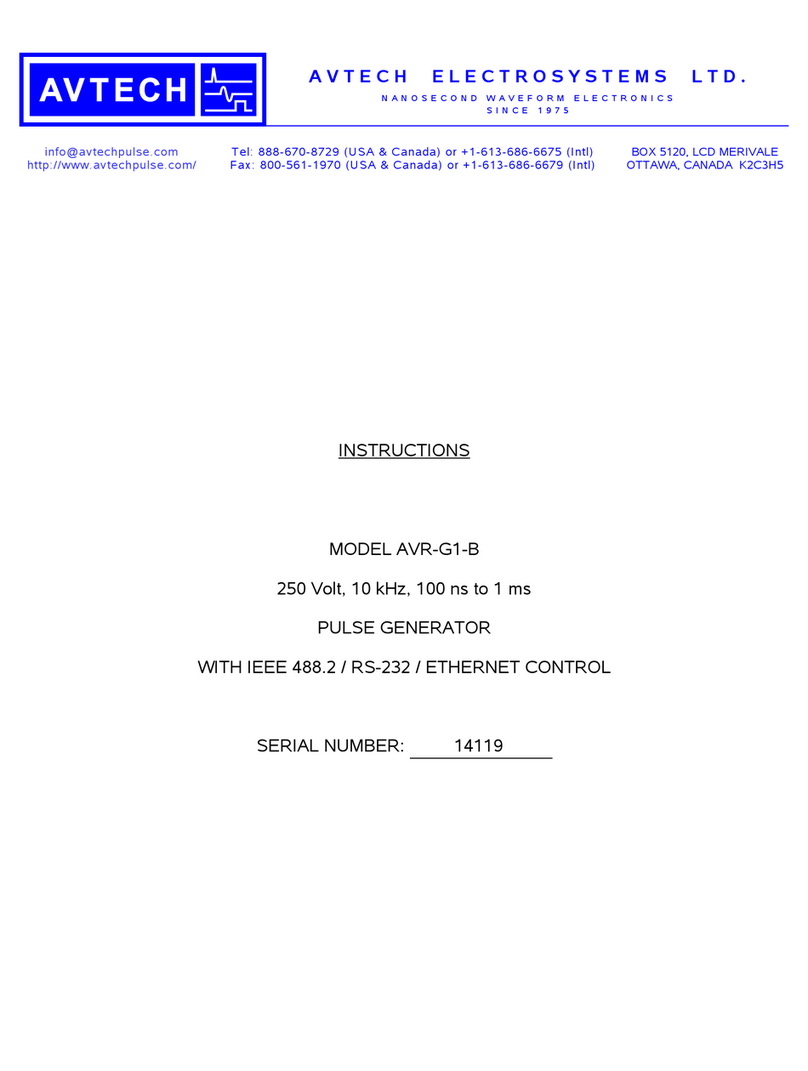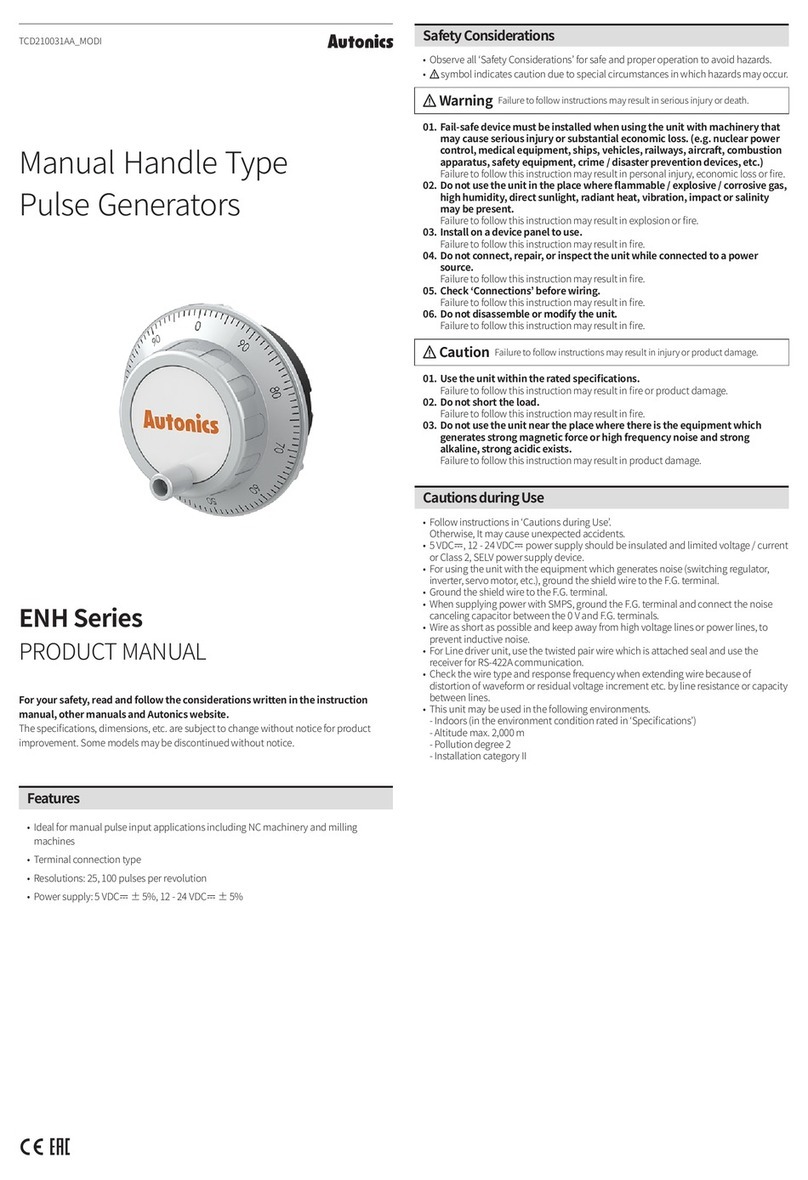B+K precision 4033 User manual

Model: 4033, 4034
50 MHz Programmable Pulse
Generator
USER MANUAL

2
Safety Summary
The following safety precautions apply to both operating and maintenance personnel and must be
observed during all phases of operation, service, and repair of this instrument. Before applying power,
follow the installation instructions and become familiar with the operating instructions for this
instrument.
Failure to comply with these precautions or with specific warnings elsewhere in this manual violates
safety standards of design, manufacture, and intended use of the instrument. B&K PRECISION
assumes no liability for a customer’s failure to comply with these requirements.
GROUND THE INSTRUMENT
To minimize shock hazard, the instrument chassis and cabinet must be connected to an electrical
ground. This instrument is grounded through the ground conductor of the supplied, three-conductor ac
power cable. The power cable must be plugged into an approved three-conductor electrical outlet. Do
not alter the ground connection. Without the protective ground connection, all accessible conductive
parts (including control knobs) can render an electric shock. The power jack and mating plug of the
power cable meet IEC safety standards.
DO NOT OPERATE IN AN EXPLOSIVE ATMOSPHERE
Do not operate the instrument in the presence of flammable gases or fumes. Operation of any electrical
instrument in such an environment constitutes a definite safety hazard.
KEEP AWAY FROM LIVE CIRCUITS
Instrument covers must not be removed by operating personnel. Component replacement and internal
adjustments must be made by qualified maintenance personnel. Disconnect the power cord before
removing the instrument covers and replacing components. Under certain conditions, even with the
power cable removed, dangerous voltages may exist. To avoid injuries, always disconnect power and
discharge circuits before touching them.
DO NOT SERVICE OR ADJUST ALONE
Do not attempt any internal service or adjustment unless another person, capable of rendering first aid
and resuscitation, is present.
DO NOT SUBSTITUTE PARTS OR MODIFY THE INSTRUMENT
Do not install substitute parts or perform any unauthorized modifications to this instrument. Return the
instrument to B&K Precision for service and repair to ensure that safety features are maintained.
WARNINGS AND CAUTIONS
WARNING and CAUTION statements, such as the following examples, denote a hazard and appear
throughout this manual. Follow all instructions contained in these statements.
A WARNING statement calls attention to an operating procedure, practice, or condition, which, if not
followed correctly, could result in injury or death to personnel.
A CAUTION statement calls attention to an operating procedure, practice, or condition, which, if not
followed correctly, could result in damage to or destruction of part or all of the product.
WARNING:
Do not alter the ground connection. Without the protective ground connection, all
accessible conductive parts (including control knobs) can render an electric shock.
The power jack and mating plug of the power cable meet IEC safety standards.
WARNING:
To avoid electrical shock hazard, disconnect power cord before removing covers.
Refer servicing to qualified personnel.

3
CAUTION:
Before connecting the line cord to the AC mains, check the rear panel AC line
voltage indicator. Applying a
line voltage other than the indicated voltage can
destroy the AC line fuses. For continued fire protection, replace fuses only with
those of the specified voltage and current ratings.
CAUTION:
This product uses components which can be damaged by electro-
static discharge
(ESD). To avoid damage, be sure to follow proper procedures for handling, storing
and transporting parts and subassemblies which contain ESD-
sensitive
components.
Compliance Statements
Disposal of Old Electrical & Electronic Equipment (Applicable in the European
Union and other European countries with separate collection systems)
This product is subject to Directive 2002/96/EC of the
European
Parliament and the Council of the European Union on waste
electrical and electronic equipment (WEEE) , and in
jurisdictions
adopting that Directive, is marked as being put on the market
after August 13, 2005, and should not be disposed of as
unsorted
municipal waste. Please utilize your local WEEE collection
facilities in the disposition of this product and otherwise
observe all applicable requirements.
Safety Symbols
Connect to safety earth ground using the wire recommended in the user manual.
This symbol on an instrument indicates that the user should refer to the operating
instructions located in the manual.
Electrical Shock hazard.

4
Table of Contents
Safety Summary .............................................................................................. 2
Section 1 .......................................................................................................... 6
Introduction........................................................................................................................ 6
1.1 Introduction..............................................................................................................................................6
1.2 Description...............................................................................................................................................6
1.3 Safety Remarks....................................................................................................................................... 6
1.4 Package Contents ................................................................................................................................... 6
Specifications..................................................................................................................... 7
Section 2 .......................................................................................................... 9
Installation.......................................................................................................................... 9
2.1 Introduction..............................................................................................................................................9
2.2 Mechanical Inspection.............................................................................................................................9
2.3 Initial Inspection.......................................................................................................................................9
2.4 Instrument Mounting................................................................................................................................ 9
2.5 Product Dimensions ................................................................................................................................ 9
2.6 Power Requirements.............................................................................................................................10
2.7 Grounding Requirements ......................................................................................................................10
2.8 Signal Connections................................................................................................................................ 10
2.9 RS-232 Connection ...............................................................................................................................13
2.10 RS-232 Configuration..........................................................................................................................14
2.11 GPIB Address...................................................................................................................................... 14
2.12 GPIB Connections...............................................................................................................................14
Section 3 ........................................................................................................ 15
Operating Instructions .................................................................................................... 15
3.1 General Description...............................................................................................................................15
3.2 Display Window.....................................................................................................................................16
3.3 Front Panel Controls..............................................................................................................................17
3.4 Back Panel Controls..............................................................................................................................17
3.5 Output connectors .................................................................................................................................19
3.6 MENU Keys...........................................................................................................................................19
3.7 ON Key .................................................................................................................................................. 29
3.8 Cursor Movement Keys......................................................................................................................... 29
3.9 Rotary Input Knob..................................................................................................................................29
3.10 Power-On Settings ..............................................................................................................................30
3.11 Memory................................................................................................................................................30
3.12 Displaying Errors .................................................................................................................................30
3.13 Pulse Definitions..................................................................................................................................31
3.14 Pulse Parameter Limitations................................................................................................................ 32
3.15 Pulse Definitions..................................................................................................................................33
Section 4 ........................................................................................................ 35
Programming.................................................................................................................... 35
4.1 Overview................................................................................................................................................35
4.2 Device State .......................................................................................................................................... 36
4.3 Interface Function Subsets....................................................................................................................37
4.4 Device Address......................................................................................................................................37
4.5 Message Exchange Protocol.................................................................................................................37

5
4.6 Instrument Identification ........................................................................................................................38
4.7 Instrument Reset ...................................................................................................................................38
4.8 Self Test.................................................................................................................................................39
4.9 Command Syntax..................................................................................................................................39
4.10 Status Reporting..................................................................................................................................41
4.11 IEEE 488.2 Common Commands and Queries................................................................................... 45
4.12 Instrument Control Commands............................................................................................................48
4.13 IEEE 488.1 Interface Messages..........................................................................................................64
4.14 SCPI Command Tree..........................................................................................................................65
4.15 ASCII and GPIB Code Chart ............................................................................................................... 67
4.16 RS-232 Programming..........................................................................................................................69

6
Section 1
Introduction
1.1 Introduction
This manual contains information required to operate, program, check, and maintain the 50 MHz programmable pulse
generator.
1.2 Description
The Model 4033 and 4034 are a high performance programmable pulse generators. The instrument generates pulse
with a repetition rate to 50 MHz, width from 10 ns, variable delay, variable transition times and amplitude. The pulses
can be output in continuous, triggered, gated, or burst mode with an internal or external trigger signal.
The model 4033 and 4034 can be remotely operated via RS232 or GPIB interface bus and is SCPI compatible.
1.3 Safety Remarks
The model 4033 and 4034 are SAFETY CLASS 1 instruments. Before operation, review the safety summary at the
beginning of the manual.
1.4 Package Contents
The following list of items and accessories come in the package:
1. 4033 or 4034 Pulse Generator
2. AC power cord
3. CD containing user manual
4. Test report and certificate of calibration
5. RS-232 Serial Cable

7
Specifications
NOTE
Specifications listed in manual are applicable after a powered 30 minute warm-up into a 50 Ωload
All timing characteristics are measured at 50% of amplitude with fastest edge
Specifications are verified according to the performance check procedures.
Specifications not verified in the manual are either explanatory notes or general performance characteristics only.
Specifications and information is subject to change without notice. For the most current and correct data please
visit www.bkprecision.com
MODELS
4033
4034
CHANNELS
1
2
FREQUENCY
0.1 Hz to 50 MHz
TIMING CHARACTERISTICS
PERIOD
Range (single pulse)
20 ns to 10 s (50 MHz to 0.1 Hz repetition rate)
Range (double
pulse)
40 ns to 10 s (25 MHz to 0.1 Hz repetition rate)
Resolution
Up to 6 digits, limited to 10 ps
Accuracy
±
0.01 %
Jitter
< 0.01 % of setting +20 ps on Period, Width and Delay
WIDTH
Range
10 ns to (Period – 10 ns)
Resolution
Up to 6 digits, limited to 100 ps
Accuracy
±
(0.5% of setting +500 ps)
Double Pulse
±
(0.5% of setting +3 ns) for the second pulse
DELAY
Range
0ns to (Period – Width – 10 ns)
Resolution
Up to 6 digits, limited to 100 ps
Accuracy
±(0.5% of setting +500 ps)
DUTY
CYCLE
Range
1 to 99%
Resolution
3 digits (0.1%)
Accuracy
Limited by width and pulse accuracy
OUTPUT CHARACTERISTICS
AMPLITUDE
High Level
Range
-9.90 V to +10 V into 50 ohms load (-19.80 V to +20 V into open circuit)
Low Level
Range
-10 V to +9.90 V into 50 ohms load (-20 V to +19.80 V into open circuit)
Amplitude Range
0.1V to 10V p-p into 50 ohms load (20 Vp-p max into open circuit)
Resolution
3 digits limited to 10 mV
Accuracy
±
1% of setting
±
10 mV into 50 ohms
Aberrations
<5% + 20 mV into 50 ohms load, for pulse levels between ±5 V
Output
Resistance
50 ohms
Offset Accuracy
±
1%
±
25 mV
OPERATING MODES
Continuous
Output continuous at programmed period rate
Triggered
Output quiescent until triggered by an internal, external, GPIB or manual
trigger, then generates one cycle at programmed period rate
Gated
Same as triggered mode except pulses are output for the duration of the
gated signal. The last cycle started is completed
Burst
Same as triggered mode for programmed number of cycles from 2 to
999,999 as set by the N-BURST function
External Width
Trigger duration and rate sets pulse width and repetition

8
PULSE FUNCTIONS
Single
One pulse at each selected period up to 50 MHz repetition rate
Double
One pair of pulses at each period up to 25 MHz repetition rate. Both pulses
have the same selected width; the position of the second pulse set by the
delay control.
TRANSITION TIMES
Range
<6 ns to 100 ms variable. Leading and trailing edges settable separately
and limited to 20:1 ratio between settings into one of the following ranges:
5ns-100 ns; 50 ns-1.0 us; 500 ns-10 us; 5.0 us-100 us; 50 us-1.0 ms; 500
us-10 ms, 5 ms – 100 ms
Resolution
3 digits limited to 10 ps
Accuracy
±(5% of setting +2ns)
Linearity <5% deviation from
a straight line between 10% and 90% points, for
transitions > 50 ns
INTERNAL TRIGGER
Range
100 ns to 100 s
Resolution
4 digits limited to 100 ns
Accuracy
±
0.01%
INPUT AND OUTPUT
TRIGGER
INPUT
Sensitivity
200 mVp-p minimum
Minimum Width
10 ns
Maximum Rate
50 MHz
Input Impedance
10 kΩ
Input Protection
+15V DC plus peak AC
Range
Selectable from -10 V to +10 V
Resolution
3 digits limited to 10 mV
Slope Selection
Positive or Negative
SYNC OUTPUT
A TTL level pulse at the programmed period. Output impedance is 50 Ω,
protected against short circuit and up to ±15 V accidental input. The high
level is >2 V into 50 ohms and with 3.5 ns typical transition times.
GPIB PROGRAMMING
Interface
GPIB and RS-232, IEEE-488.2 and SCPI compatible
GPIB Function Codes
SH1, AH1, T6, L4, SR1, RL1, PP0, DC1,DT1, C0, E2
GENERAL
Memory
Non volatile, stores up to 99 complete panel settings. Last user setup also
retained at power down
Power Requirements 100-240 V, ±10%, 48-66 Hz, 50 VA maximum
Dimensions WxHxD
8.4 x 11.8 x 3.5 inches (213 x 300 x 88 mm)
Net Weight
Approx. 3 kg
EMC
Conforms to EN55011 class B for radiated and conducted emissions
Electrical Discharge Immunity
Conforms to EN55082
Safety Specifications
Conforms to EN61010, CE Approved
Operating Temperature
32 °F to 122 ° F (0 °C to 50 °C)
Storage Temperature
-4 ° F to 140 °F (-20 °C to 60 °C)
Humidity
90% RH at 32 °F to 86 °F (0 °C to 30 °C)

9
Section 2
Installation
2.1 Introduction
This section contains installation information, power requirements, initial inspection and signal connections for
Model 4033 and 4034.
2.2 Mechanical Inspection
This instrument was carefully inspected before shipment. Upon receipt inspect the instrument for damage that might
have occurred in transit. If there is damage due to shipping, file a claim with the carrier who transported the unit.
The shipping and packing material should be saved if reshipment is required. If the original container is not to be
used, then use a heavy carton box. Wrap the unit with plastic and place cardboard strips across the face for
protection. Use packing material around all sides of the container and seal it with tape bands. Mark the box
"FRAGILE".
2.3 Initial Inspection
After the mechanical inspection, verify the contents of the shipment (accessories). If the contents are incomplete, or
if the instrument does not pass the specification acceptance tests, notify the local service center. The unit is
calibrated and ready for use upon receipt. For a detailed performance check procedure, please see section 5 of the
manual.
2.4 Instrument Mounting
The model 4033 and 4034 programmable pulse generators are intended for bench use. The instrument includes a
front feet tilt mechanism for optimum panel viewing angle. The instrument does not require special cooling when
operated within conventional temperature limits. The unit can be installed in a closed rack or test station if proper air
flow is assured. A 5 cm minimum clearance must be provided at the rear of the unit for proper convection cooling.
2.5 Product Dimensions
300 mm
213 mm
88 mm

10
2.6Power Requirements
The model 4033 and 4034 can be operated from any source of 100-240V +/-10% AC, at a frequency from 48Hz to
66Hz. The maximum power consumption is 50 VA.
WARNING
THE LINE POWER VOLTAGE OF THE INSTRUMENT IS NOTED ON THE AC INPUT PLUG. TO
PREVENT DAMAGE TO THE INSTRUMENT, CHECK FOR PROPER MATCH OF LINE VOLTAGE
AND PROPER FUSE TYPE AND RATING.
The instrument power fuse is located in the AC input plug. To access the fuse, first disconnect the power cord and
then remove the fuse cartridge. Use T1A 250V fuse only, as labeled in the rear panel of the unit.
2.7 Grounding Requirements
For the safety of operating personnel, the instrument must be grounded. The central pin on the AC plug grounds the
instrument when properly connected to the ground wire and plugged into proper receptacle. The power jack and the
mating plug of the supplied power cable meet IEC safety standards.
WARNING
TO AVOID PERSONAL INJURY DUE TO SHOCK, THE THIRD WIRE EARTH GROUND MUST BE
CONTINUOUS TO THE POWER OUTLET. BEFORE CONNECTION TO THE POWER OUTLET,
EXAMINE ALL CABLES AND CONNECTIONS BETWEEN THE UNIT AND THE FACILITY POWER
FOR A CONTINUOUS EARTH GROUND PATH.
THE POWER CABLE MUST MEET IEC SAFETY STANDARDS.
2.8 Signal Connections
Use RG58U 50 Ωor equivalent coaxial cables for all input and output signals to and from the instrument. Below
specifies the BNC connectors on the instrument:
OUTPUT – Up to 10 Vpp into 50 Ω impedance (20 Vpp into open circuit). The instrument is protected from short
circuit to ground.
TRIG IN – 10 kΩ impedance, selectable positive or negative slope, variable level from – 10 V to + 10 V. Input
protected to ±15 V.
SYNC OUT – A positive pulse signal in phase with the main output. TTL levels with a 50 Ω source impedance and
with 3.5 ns typical transition times.

11
2.8.1 Maintaining Pulse Fidelity
Due to the extremely fast pulse rise times obtained from the instrument, special consideration must be given to
preserve pulse fidelity. Even at low repetition rates, high frequency components are present in the output waveform.
Use high quality coaxial cables, attenuators and terminations.
Note: RG 58 type coaxial cable and typical BNC connectors exhibit impedance tolerances which may cause visible
reflections. For maximum fidelity, use short, high quality, 50 Ωcoaxial cables.
When signal comparison measurements or time difference determinations are made, the two signals from the test
device should travel through coaxial cables with identical loss and time delay characteristics.
When making connections that are not in a 50 Ωenvironment, keep all lead lengths short, 1/4 inch or less.
2.8.2 Impedance Matching
A mismatch, or different impedance in a transmission line, generates a reflection back along the line to the source.
The amplitude and polarity of the reflection are determined by the load impedance in relation to the characteristic
impedance of the cable. If the load impedance is higher than the characteristic impedance of the line, the reflection
will be of the same polarity as the applied signal. If it is lower, the reflection will be of opposite polarity. These
reflections add or subtract from the amplitude of the incident pulse causing distortion and irregular pulse shapes.
Impedance-matching network that provides minimum attenuation
A simple resistive minimum attenuation impedance matching network that can be used to match the instrument
output into relatively low impedance is shown in the above figure. To match impedance with the illustrated network,
the following conditions must exist:
and
Therefore:
(
)
R
Z
R
R
Z
R
Z
1
2
2
1
2
2
1
+
+
+
=
RR Z R
Z R
11 1 2
1 2
++
+

12
R1 R2 = Z1 Z2, and R1 Z1 = R2 (Z2-Z1)
or
and
For example: to match a 50Ωsystem to a 125Ωsystem, Z1 equals 50Ωand Z2 equals 125Ω
Therefore:
Ω
and
Ω
Although the illustrated network provides minimum attenuation, for a purely resistive impedance-matching device,
the attenuation as seen from one end does not equal that seen from the other end. A signal (E1) applied from the
lower impedance source, encounters a voltage attenuation (A1) which is greater than 1 and less than 2, as follows:
A signal (E2) applied from the higher impedance source (Z2) encounters a greater voltage attenuation (A2), which is
greater than 1 and less than 2 (Z2/Z1):
In the example of matching 50Ωto 125Ω,
and
R Z Z Z1 2 2 1= −( )
R Z Z
Z Z
2 1 2
2 1
=
−
R1 125 125 50 968= − =( ) .
R2 50 125
125 50 64 6=
−
=.
AE
ER
Z
11
21
21= = +
AE
ER
RR
Z
22
11
21
11= = + +
A1968
125 1 177= + =
..
A2968
64 6 968
50 1 4 43= + + =
.
...

13
The illustrated network can be modified to provide different attenuation ratios by adding another resistor (less than
R1) between Z1 and the junction of R1 and R2.
When constructing such a device, the environment surrounding the components should also be designed to provide
smooth transition between the impedances. Acceptable performance can be obtained with discrete components using
short lead lengths; however, a full coaxial environment is preferred.
The characteristic impedance of a coaxial device is determined by the ratio between the outside diameter of the inner
conductor to the inside diameter of the outer conductor expressed as:
2.8.3 Rise Time Measurements in Linear Systems
Consider the rise time and fall time of associated equipment when measuring the rise time or fall
time of a linear device. If the rise time of the device under test is at least ten times slower than
the combined rise times of the instrument, the monitoring oscilloscope, and associated cables, the
error introduced will not exceed 1%, and usually may be ignored. If the rise time or fall time of
the test device is less than ten times slower than the combined rise times of the testing system,
determine the actual rise time of the device under test by using the following formula:
Rt equals the overall rise time or fall time of the entire measurement system and R1, R2, R3, etc.
are the rise times or fall times of the individual components in the system.
2.9RS-232 Connection
The rear panel RS-232 connector is a standard DB-9 male connector configured as a DCE. The pin assignments
are defined in the table below:
ZD
d
0138 10=
ε
log
Rt Rt Rt Rt= + + +( ) ( ) ( ) ......
122232

14
DB-9 pin
Name
Note
1
2
3
4
5
6
7
8
9
-
TXD
RXD
-
GND
-
RTS
CRS
-
-
Transmit Data
Receive Data
-
Signal ground
-
Request to Send
Clear to send
-
*Note: Use a Null-modem or cross over cable (pin 2 and 3 switched) in order to communicate with instrument.
2.10 RS-232 Configuration
The instrument use 8 data bits, 1 stop bit, no parity and baud rate selectable from 2400 to 115K (2400, 4800,
9600, 19200, 38400, 57600, 115200). By default, the instrument is set at 19200-8-N-1.
Note: If 115K baudrate speed is used, ensure that the RS232 cable is short and can support this speed. Otherwise,
there may be some instability and intermittent data transmission failure between the interfacing computer and
the instrument.
2.11 GPIB Address
The address can be changed from the front panel by using the "UTILITY" menu.
2.12 GPIB Connections
The rear panel GPIB connector is an AMPHENOL 57-10240 or equivalent, and connects to a standard IEEE-488
bus cable connector. The GPIB line screens are not isolated from chassis and signal ground.

15
Section 3
Operating Instructions
3.1 General Description
This section describes the displays, controls and connectors of the Model 4033 and 4034 - Pulse Generators.
All controls for the instrument local operation are located on the front panel. The connectors are located on both
front and rear panels.
Figure 3.1 - Front Panel View
1. Power ON-OFF - Applies and removes AC power to the unit
2. Display Window - Displays all instrument data and settings on a LCD.
3. FI-F5 Keys - Select the menu options that appear on the bottom section of the LCD display.
4. Menu Keys - Select menu options for waveform parameters (PARAM), output levels
(OUTPUT), pulse edges (PULSE), triggering modes (MODE), setup
1
2
3
7
8
9
11
14
5
6
15
16
12
10
4
(Model 4034 only)
13
(Model 4033)

16
configurations (SETUP), and utility options (UTIL).
5. Numerical Keypad - Numeric entry keys for entering values for various functions and modes
6. Unit Setting Keys - Quick keys for setting units for frequency, time, and amplitude
7. Rotary Knob - Used to increment/decrement numerical values or to scan through the possible
selections.
8. Cursor Keys - Used to move the cursor (when visible) to either left or right when modifying
values of various parameters.
9. Output ON - Controls the main output signal. In model 4033, the output status is ON when
display shows “Out On” and the button lights up. In Model 4034, display will
show “On” next to “ch1” and/or “ch2” indicators depending on which channel is
selected to be on.
10. Channel Output - (model 4034) Dual BNC independent channel outputs (50 Ω) of pulse signal.
11. Output ON - (model 4033) Controls the main output signal. The output status is ON when
illuminated.
12. Channel Output - (model 4033) BNC channel output (50 Ω).
13. Sync Out - (model 4033) Sync output, 50 Ω 5V TTL level. Sync out for dual channel model
4034 is located in the rear panel of the instrument.
14. CHAN Key - (model 4034 only) Channel select key
15. MAN TRIG Key - Sends manual trigger pulse when pushed (requires instrument to be in manual
trigger mode)
16. ENTER Key - Used for confirming parameter adjustments and settings.
3.2 Display Window
The pulse generator has a graphical LCD display that can display up to 160 x 80 dots. When you power-on the unit a
parameter (Frequency) and its current settings appear in the display. The bottom displays a menu that corresponds to the
function, parameter or mode display selected.
Figure 3.2 - LCD Display Screen
1. Channel/Output Display
Displays the current selected channel (when highlighted). (For model 4034 only). Also displays
highlighted text “Out On” when output is ON (For model 4033) or displays a highlighted text “On” next
to “Ch 1” and/or “Ch 2” when either or both channel outputs are ON (For model 4034).
1
2
3
4
5
6
7

17
2. General Waveform Display
Displays the general waveform being generated in the channel.
Note: Waveform shown is approximated and scaled down. It does not show the exact representation of
the waveform at the output.
3. DEL Mode Display
Displays delay setting of the pulse. Alternatively, it can also display other parameters in other menu
items.
4. Menu Functions Display
Displays the menu options available. Use F1-F5 keys on front panel to select the options.
5. Secondary Parameter Display
Displays the values of parameters selected in the menu.
Depending on the options chosen, various parameters will display with a cursor for adjusting their values.
For example, width or duty cycle can be displayed.
6. Main Parameter Display
Displays the main parameter value. When highlighted, it can be adjusted with numeric keypad or rotary
knob. It can, for example, adjust frequency or period.
7. Mode Display
Displays the current mode of the generator. This can be the trigger mode of the power supply.
3.3 Front Panel Controls
The front-panel controls select, display, and change parameter, function, and mode settings. Use the rotary input knob
and the cursor movement keys to enter data into the pulse generator.
To change a setting:
1.Press the key that leads to a required item.
2. Move cursor using cursor keys to the appropriate position in the numeric field.
3. Use the rotary input or the numerical keyboard to change the value of the displayed item. Changes take effect
immediately.
The following subsections describe the function of each front panel key and connector.
3.4 Back Panel Controls
The pulse generator has 4 BNC Connectors on the rear panel where you can connect coaxial cables. These coaxial
connectors are labeled accordingly and serve as carrier lines for input and output signals delivered to and from the
pulse generator.

18
Figure 3.3 - Back Panel View
1. Options 50 Ω- Reserved for future use.
2. Options TTL - Reserved for future use.
3. Trig In - Use this connector to apply an external trigger or gate signal, depending on the waveform
generator setting, to the generator. Maximum input is ± 15 V.
4. CTRL IN - Not used
5. GPIB Interface - Use to interface with a computer via GPIB for remote communication.
Model 4034
12
11
3
8
10
9
5
6
7
Model 4033
1
3
4
5
6
8
10
9
2
7

19
6. RS-232 Interface - This is a standard RS-232 port used for remote interface. Null modem or cross
serial cable is required to communicate with a PC via this port.
7. Earth GND - This screw is the earth ground that is tied to the chassis.
8. AC Power Connector - Used to connect power cable to AC line source.
9. Fuse Box - Fuse compartment.For replacement, use T1A, 250V fuse only.
10. Cooling Fan - To ensure proper cooling, please leave room between the fan output and other objects
with at least one feet distance.
11. SYNC OUT - (Model 4034 only). 50 Ω TTL sync output for channel 1.
12. TRIG IN and SYNC OUT- (Model 4034 only). TRIG IN and SYNC OUT BNC connectors for
channel 2. SYNC OUT is a 50 Ω TTL level signal. TRIG IN accepts maximum ± 15 V.
3.5 Output connectors
The pulse generator output circuits operate as a 50 Ωvoltage source working into a 50 Ωload. At higher frequencies,
un-terminated or improperly terminated output cause aberrations on the output waveform. In addition, loads less than
50 Ωreduce the waveform amplitude, while loads more than 50 Ωincrease waveform amplitude.
Excessive distortion or aberrations caused by improper termination are less noticeable at lower frequencies.
To ensure pulse integrity, follow these precautions:
1. Use good quality 50 Ωcoaxial cable and connectors.
2. Make all connections tight and as short as possible.
3. Use good quality attenuators if it is necessary to reduce pulse amplitudes applied to sensitive circuits.
4. Use termination or impedance-matching devices to avoid reflections.
5. Ensure that attenuators and terminations have adequate power handling capabilities.
If there is a DC voltage across the output load, use a coupling capacitor in series with the load. The time constant of
the coupling capacitor and load must be long enough to maintain pulse flatness.
Impedance Matching
If the waveform generator is driving a high impedance, such as the 1 MΩinput impedance (paralleled by a stated
capacitance) of an oscilloscope vertical input, connect the transmission line to a 50 Ωattenuator, a 50 Ω
termination and to the oscilloscope input. The attenuator isolates the input capacitance of the device and terminates
the waveform generator properly.
3.6 MENU Keys
These keys select the main menus for displaying or changing a parameter, function or mode. Below is the hierarchy
and selections of the menu tree.
MENU TREE
-PARAM
oPERIOD | FREQ
oWIDTH | DUTY
oDELAY
oINDEP | CH1 (When CH2 is selected only)
oSINGLE | DOUBLE
-OUTPUT
oHILVL
oLOLVL
oPREDEF
ECL

20
TTL
CMOS
USER
HIPRED | LOPRED
oOUTPUT LIMITS
LIM OF
LIM ON
HILIM
LOLIM
PREV
-PULSE
oRISE
oFALL
oEQUAL
oNORM | COMPL
-MODE
oCONT
oTRIG
MAN (Manual Trigger)
INT (Internal Trigger Rate)
EXT (External Trigger)
PREV
oGATE
MAN (Manual Gate Trigger)
INT (Internal Gate Trigger Rate)
EXT (External Gate Trigger)
PREV
oBURST
MAN (Manual Burst)
INT (Internal Burst Rate)
EXT (Burst External)
NBRST (Number of Bursts)
PREV
oEXTWID
-SETUPS
oRECALL
oSTORE
oCLEAR ALL
-UTIL
oGPIB (ACTIVE) (GPIB Address)
oRS232 (ACTIVE) (Baudrate)
oINTEN
oPOWER (Power On Setup)
3.6.1 PARAMETER Menu
This key selects and displays the waveform frequency, amplitude, offset and external reference and allows changing the
parameter data.
Frequency Menu
F1: PERIOD/FREQ - Selects and displays the period or the pulse frequency. Change the values using the
cursor keys, rotary knob or numerical keys. If a certain setting can't produce the
waveform at the desired parameters, the generator displays an error message. While the
This manual suits for next models
1
Table of contents
Other B+K precision Pulse Generator manuals

